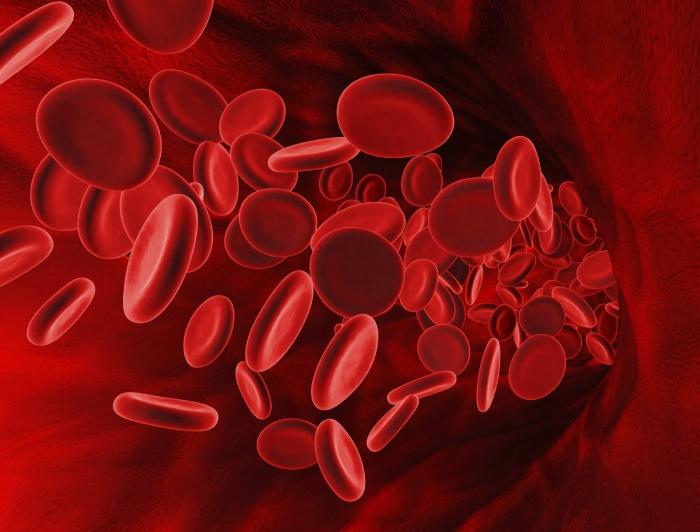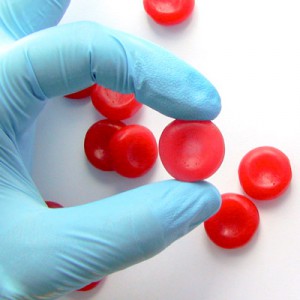Even from the school course of anatomy, everyone knows that red blood cells are called red blood cells. Each cell individually resembles a disc or tablet with thickened edges. It is this form that helps erythrocytes to effectively perform their function, namely, to carry vital oxygen to the tissues.
The red color of cells is due to their high content of hemoglobin, a special protein that contains iron. It is this one that binds oxygen and then releases it. Erythrocytes are 2/3 composed of hemoglobin. When levels drop, doctors usually talk about anemia, an oxygen starvation in the body caused by a lack of iron.
The bone marrow is responsible for the formation of red blood cells, where they are formed under the influence of a special substance produced by the kidneys, the so-called erythropoietin.
Young red blood cells are called reticulocytes. Only mature erythrocytes that do not contain nuclei and organelles should be found in the blood, otherwise we can talk about pathology.
Due to the slowed down metabolism, erythrocytes are considered long-livers among blood cells, they live for 120 days.
When this period expires, red blood cells are worn out and destroyed in the spleen and liver, and new cells are formed in the bone marrow. This process is continuous throughout a person's life. If something in this chain is violated, various diseases arise.
The number of red blood cells in the blood is determined using.It is very difficult to count the number of cells for the entire blood volume, their number is huge, so no other blood cells can compare with erythrocytes in number. For this reason, the amount is considered for a certain volume of blood, namely one cubic millimeter.The rate fluctuates depending on gender, age of a person, his lifestyle and place of residence. If the erythrocytes in the blood are increased, the reasons can be very different, from banal physiological to serious pathologies.
The reasons for the increase in red blood cells

A high level of red blood cells in the blood is called erythrocytosis. There can be a lot of reasons. The doctor will evaluate other tests as well as symptoms and history and make a conclusion about the diagnosis.
Main reasons:
- Lack of fluid. The most common cause of this condition is dehydration, when the volume of blood decreases, due to which the number of red blood cells increases by a certain amount of blood. Dehydration can be a consequence of sweltering heat, when a large amount of fluid evaporates through the skin, disturbed drinking regime, and heavy physical exertion. It is enough to drink more water and after a couple of days the level of red blood cells will return to normal.
- Erythremia. This is commonly referred to as a blood disorder in which the production of red blood cells in the bone marrow is accelerated. The causes of this condition are unknown, and there is no effective treatment either.
- Diseases of the lungs. When the lungs are affected, there is often a lack of oxygen. A person cannot breathe normally, oxygen starvation sets in. To cope with this condition, the bone marrow begins to produce more red blood cells. The same can be said for smoking. In people who smoke, it often shows an increased content of red blood cells in the blood. And all because of nicotine, tar and carbon dioxide, which enter the body in large quantities. To remove toxic substances and provide oxygen to tissues, the body begins to produce more red blood cells.
- Kidney disease. As mentioned above, it is in the kidneys that erythropoietin, a substance that stimulates the production of red blood cells, is produced. In some kidney diseases, this substance begins to be produced very actively, which provokes an increase in the level of red blood cells in the blood.
- Heart disease. The main danger of all heart defects is that venous and arterial blood, which should not touch, mix. When oxygenated blood and blood with carbon dioxide mix, transport of oxygen to the tissues becomes difficult. To compensate for this deficiency, the bone marrow produces more red blood cells.
 The consequences should be discussed in cases where the causes of this condition are pathological. In some cases, there may not be any consequences. For example, an increased level of red blood cells is considered normal during time. All due to the increase in blood volume and its thinning. Therefore, mild anemia due to iron deficiency is also considered normal.
The consequences should be discussed in cases where the causes of this condition are pathological. In some cases, there may not be any consequences. For example, an increased level of red blood cells is considered normal during time. All due to the increase in blood volume and its thinning. Therefore, mild anemia due to iron deficiency is also considered normal.
An increased level of red blood cells in newborns, and there is no pathology here either. In order to provide the tissues and organs of the baby with oxygen until the moment of his birth, red blood cells are produced in greater quantities. Some time after birth, the number of red blood cells returns to normal.However, in diseases that cause an accelerated secretion of red blood cells, the consequences can be very serious.
The faster red blood cells are produced, the more likely they are immature and will not be able to fully perform their function.
As a result of such a failure, almost all organs and tissues of the body suffer. Blood clots, which increases the risk of blood clots. The liver and spleen increase in size. If this condition continues to worsen, it can be fatal.
An interesting video about the structure and functions of red blood cells.
Erythrocytosis is not always noticeable immediately. With a chronic slow course of the disease, symptoms practically do not appear, since the body has time to compensate for this condition. However, his reserves are not eternal. Sooner or later, negative consequences will manifest themselves.Preventive measures include general strengthening of the body, proper nutrition, sufficient consumption of pure water, the quality of which must be closely monitored. If the water is oversaturated with chlorine, this can lead to subsequent erythrocytosis.
Excessive consumption of soda also affects the production of red blood cells. If you drink 2 liters or more daily, health problems cannot be avoided.
Decrease in the level of red blood cells in the blood

If the level of red blood cells in the blood is low, it can also signal various diseases:
- ... As you know, there are different types of anemias. With some of them, for example, with hemolytic anemia, the level of red blood cells decreases.
- Hereditary diseases. Some hereditary diseases are associated with a violation of the structure of the membrane of erythrocytes, as a result of which they are rapidly destroyed.
- Bleeding. With heavy bleeding of any genesis (trauma, stomach ulcer, profuse uterine bleeding, etc.), the bone marrow does not have time to replenish the loss of red blood cells, so their level in the blood falls. It is necessary to stop the bleeding and in some cases a blood transfusion will be needed.
- Diseases of the urinary tract. The kidneys and urinary tract are associated with red blood cell levels. If there are any problems with the flow, the level of red blood cells will drop.
- Bone marrow damage. All blood cells are produced in the bone marrow. This means that with pathologies of the bone marrow, the composition of the blood will change. If the bone marrow is affected by metastases due to cancer, the production of all blood cells will decrease, their shape and vitality will change.
- Infection. With some infections, such as whooping cough and diphtheria, the red blood cell count drops. These terrible and very contagious infectious diseases are currently rare, since children from three months of age are vaccinated against whooping cough, diphtheria and tetanus (DTP).
An accurate diagnosis will be made based on a number of symptoms, and a change in the level of red blood cells in is only one of them. Diagnosis and prescribing treatment should only be carried out by a specialist.
Have you noticed a mistake? Highlight it and press Ctrl + Enter to let us know.

